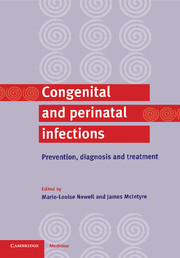Book contents
4 - Assessing the scientific value of screening for antenatal infections
Published online by Cambridge University Press: 06 July 2010
Summary
Introduction
One of the major, possibly preventable, causes of perinatal mortality and morbidity is infection. Infection during pregnancy is a relatively common occurrence. Although most infections do not have serious consequences on obstetric or perinatal outcomes, some are important causes of fetal and neonatal mortality and morbidity. Adverse consequences on the infant can be either directly due to fetal infection, such as toxoplasmosis, syphilis, rubella or herpes (Charles, 1994; Arias, 1993) or indirectly through another pathology caused by the maternal infection, such as preterm birth (Hillier et al, 1995; Romero et al., 1989; Meis et al, 1995; Smaill. 1998; McGregor et al., 1995). Infections may also cause significant maternal complications (Charles, 1994).
The implementation of any intervention for promoting health care begins with knowledge about the presence or absence of pathological or abnormal conditions that could be prevented through intervention, and detection of these conditions depends on the ability of the method used for that purpose. Thus, diagnosis is a very important component of medical care, and much medical research is carried out to try new methods of diagnosis. When a preventable, treatable, or curable condition is identified a cascade of medical and non-medical interventions is initiated, but not always in a cost-effective way. Cost-effectiveness is a trade-off between cost and medical benefit (Doubilet et al., 1986). Rapid developments in medical technology along with an increasing pressure for cost reduction within the health care system have led to a growing interest in cost-effectiveness analysis in medical literature. Unfortunately, published economic analyses in the obstetrics and gynaecology literature seldom adhere to the recommended standards for methodological assessment (Smith & Blackmore, 1998).
- Type
- Chapter
- Information
- Congenital and Perinatal InfectionsPrevention, Diagnosis and Treatment, pp. 64 - 80Publisher: Cambridge University PressPrint publication year: 2000

